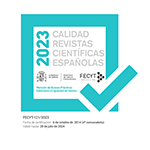El ombligo del mundo sólo era una piedra más en el camino: land art y body art: modos de horizontalización artística
Resumen
A partir de dos obras pertenecientes al land art (A circle in Huesca de Richard Long) y al body art (Psyché de Gina Pane) presentamos una lectura sobre la base del concepto rizoma, extraído de Deleuze-Guattari, que nos conducirá al de horizontalización. Con ello, imbricando arte y política, incidiremos en las implicaciones radicalmente democráticas de estas propuestas artísticas. Extraeremos tres funciones que comparten ambas: anti-jerarquía, inmediación y apertura. Enarbolando el concepto rizoma, tenderemos puentes entre las obras antedichas conjugando el análisis del ombligo en Gina Pane como centro y el perímetro de piedras de Richard Long como límite conectivo. El centro, símbolo de autoridad, eje vertebrador de un sistema cerrado, será diluido, esto es, criticado y destruido por el perímetro siempre abierto que convierte a toda frontera en porosa. En las conclusiones finales destacaremos la disolución del clásico-moderno paradigma sujeto-objeto y, sobre todo, la función del arte como señalización experiencial abogando por la comunicación abierta como eje de toda significación artística.
Descargas
Licencia
La revista Arte, Individuo y Sociedad, para fomentar el intercambio global del conocimiento, facilita el acceso sin restricciones a sus contenidos desde el momento de su publicación en la presente edición electrónica, y por eso es una revista de acceso abierto. Los originales publicados en esta revista son propiedad de la Universidad Complutense de Madrid y es obligatorio citar su procedencia en cualquier reproducción total o parcial. Todos los contenidos se distribuyen bajo una licencia de uso y distribución Creative Commons Reconocimiento 4.0 (CC BY 4.0). Esta circunstancia ha de hacerse constar expresamente de esta forma cuando sea necesario. Puede consultar la versión informativa y el texto legal de la licencia.










